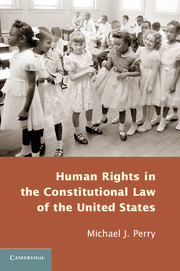Book contents
- Frontmatter
- Dedication
- Contents
- About the Author
- Introduction: Human Rights in the Constitutional Law of the United States
- Part I The Morality of Human Rights
- Part II The Constitutional Morality of the United States
- 4 Capital Punishment
- 5 The Question of Judicial Deference
- 6 The Right to Moral Equality
- 7 The Right to Religious and Moral Freedom
- 8 Same-Sex Marriage
- 9 Abortion
- Concluding Note
- Index
- References
9 - Abortion
Published online by Cambridge University Press: 05 July 2013
- Frontmatter
- Dedication
- Contents
- About the Author
- Introduction: Human Rights in the Constitutional Law of the United States
- Part I The Morality of Human Rights
- Part II The Constitutional Morality of the United States
- 4 Capital Punishment
- 5 The Question of Judicial Deference
- 6 The Right to Moral Equality
- 7 The Right to Religious and Moral Freedom
- 8 Same-Sex Marriage
- 9 Abortion
- Concluding Note
- Index
- References
Summary
In this, the final chapter, we address what has been, for us in the United States, one of the most intractable and divisive constitutional controversies since the end of the Second World War – if not the most intractable and divisive constitutional controversy.
Let us begin with this question, which, as I explained in the appendix to Chapter 3, is the third of three fundamental questions about the normative ground of human rights (NGHR): In the NGHR – according to which governments are to “act towards all human beings in a spirit of brotherhood” – does “all” human beings mean all human beings, even unborn human beings?
Even though “many describe the status of the embryo imprecisely by asking when human life begins or whether the embryo is a human being . . . no one seriously denies that the human zygote is a human life. The zygote is not dead. It is also not simian, porcine, or canine.” Philosopher Peter Singer, who is famously pro-choice, has acknowledged that “the early embryo is a ‘human life.’ Embryos formed from the sperm and eggs of human beings are certainly human, no matter how early in their development they may be. They are of the species Homo sapiens, and not of any other species. We can tell when they are alive, and when they have died. So long as they are alive, they are human life.” Similarly, constitutional scholar Laurence Tribe, a staunch pro-choice advocate, has written that “the fetus is alive.
- Type
- Chapter
- Information
- Human Rights in the Constitutional Law of the United States , pp. 158 - 178Publisher: Cambridge University PressPrint publication year: 2013



